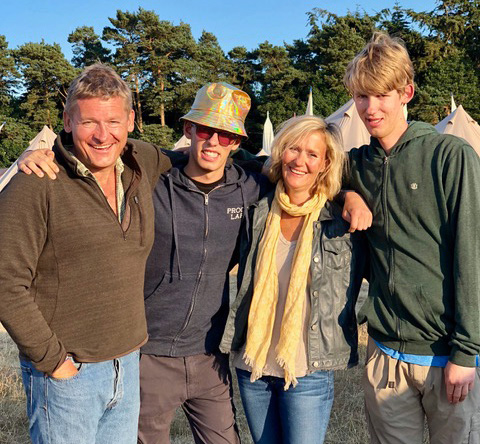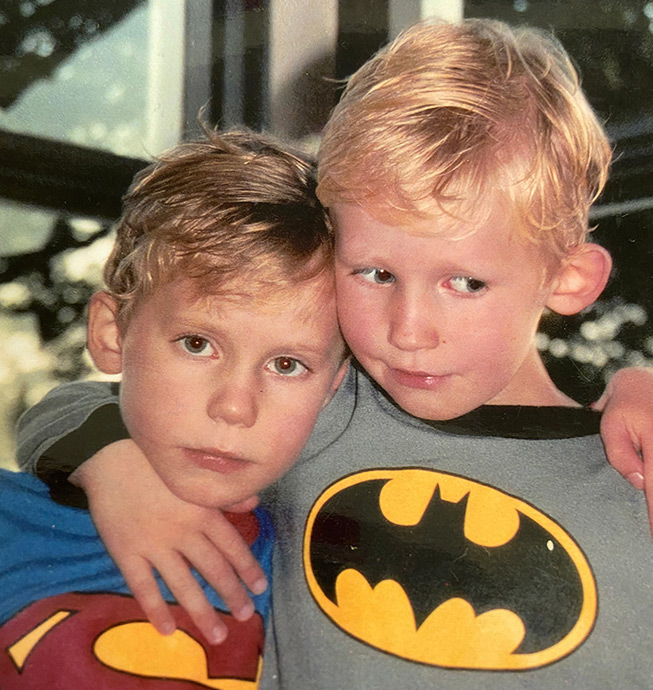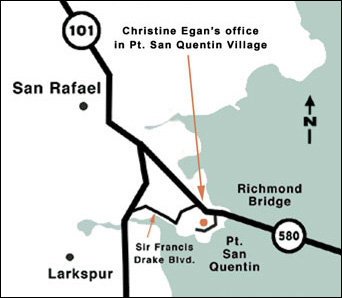Christine Egan Physical Therapy
Christine’s Pediatric Physical Therapy Blog
The Kelly’s: A Strong Family Foundation
Christine Egan MPH, PT C/NDT first met Jack Kelly when his mother, Erica Kelly brought him in for his first physical therapy appointment in November 2002. Like most children Christine worked with, Jack had missed typical developmental milestones. He struggled to crawl, walk and speak. But the more Christine worked with Jack, the more she noticed his brother Ben Kelly, who accompanied the family to the sessions, was developmentally delayed as well.
“Soon I was seeing both boys twice a week in my office,” Christine said. “Erica and I became simpatico in seeking solutions to the boy’s physical issues.”
Christine — like many other doctors and geneticists the Kelly’s had seen — knew something was different about Jack and Ben. In hindsight, Erica said the boys displayed every symptom of Myotonic Dystrophy (DM), the disease that would come to define their family. Jack and Ben were both floppy babies, had severely clubbed feet and were developmentally delayed. The puzzle pieces were there to assemble, but neither geneticists from UCSF nor a top U.K. hospital could formulate a diagnosis.
“I can’t even begin to tell you as a mother,” Erica said, “the frustration and pain I felt not being able to find answers for our boys.”
Erica became pregnant with a third child, Peter, in 2003. During a routine 10-week ultrasound, the family noticed a disturbing detail: the infant had clubbed feet, just like Jack and Ben. Peter tragically lost his heartbeat at 38 weeks. Unbeknownst to the family, Peter had DM as well.
 Despite all the mounting evidence, Erica and her husband, Jeremy Kelly, still had no answers until two years later. Erica’s brother at the age of 42 started to lose strength in his hands: a common symptom of adult-onset myotonic dystrophy. He became the first of many family members to be diagnosed with DM.
Despite all the mounting evidence, Erica and her husband, Jeremy Kelly, still had no answers until two years later. Erica’s brother at the age of 42 started to lose strength in his hands: a common symptom of adult-onset myotonic dystrophy. He became the first of many family members to be diagnosed with DM.
Erica was tested specifically for DM along with Jack and Ben — all three of them tested positive for the condition. Erica’s sister, father, uncle and many other relatives on her father’s side of the family all were diagnosed with DM, too.
Desperate to find information, Jeremy and Erica searched the web and found almost no information about DM. Fortunately, Jeremy’s father in the UK identified the Internatioanl Myotonic Dystrophy Consortium, an international coalition of DM researchers who met every two years, and he and Jeremy went to their conference in Quebec in 2005.
While Erica was quarterbacking her son’s network of doctors and therapists, Jeremy was inspired by the Consortium the set of researchers and with several other affected families they set out to fundamentally change the perception of DM.
The Myotonic Dystrophy Foundation was founded in 2007 and Jeremy joined the Board of Directors as Treasurer. For his first fundraising effort, Jeremy pledged to bike his daily commute for a year from Marin County into San Francisco, and sold off each of the 5000 total miles. The bike-a-thon effort was also the first time the Kelly’s had earnestly made their situation known to their network. “Our friends knew something was up, so it was like our ‘coming out’ letter,” Jeremy said. Jeremy raised $200,000 for the MDF through the sponsored biking. He was also able to lock down multi-year funding commitments from several large donors, which buoyed the foundation through the 2008 financial crisis.
“What became clear early on was that there was no voice for the Myotonic Dystrophy community,” said Jeremy, Myotonic’s founding board member. “We saw a huge need to create a voice for people who couldn’t create a voice for themselves. If you really want to advance the message of your disease you need a disease-specific organization.”
The Myotonic Dystrophy Foundation provides families with a referral network and clear and specific information about the disease. Armed with this information, Jeremy said families can take initiative with practical steps to improve the quality of their lives. Information on independent education plans, employment, applying for social security and adult onset care can all be accessed on the MDF website — information that did not exist when the Kelly’s first learned of their diagnosis 16 years ago.
 “We’re producing the materials for the community to advocate for themselves better,” Jeremy said. Families can access documents in the Toolkit to bring to medical appointments sicne many healthcare professionals are unfamiliar with DM. For instance, most anesthesiologists are not aware that certain types of anesthesia can induce severe complications in someone with DM. Thus, the Kelly’s bring documents to their sons’ procedures, which detail the type of anesthesia to use and the appropriate administration procedure the anesthesiologist should take.
“We’re producing the materials for the community to advocate for themselves better,” Jeremy said. Families can access documents in the Toolkit to bring to medical appointments sicne many healthcare professionals are unfamiliar with DM. For instance, most anesthesiologists are not aware that certain types of anesthesia can induce severe complications in someone with DM. Thus, the Kelly’s bring documents to their sons’ procedures, which detail the type of anesthesia to use and the appropriate administration procedure the anesthesiologist should take.
The foundation also supports primary research of the disease. Not only does MDF directly fund trials on its own, the foundation has made strategic investments to make DM a more attractive disease to researchers and the biotech and pharmaceutical industries. For example, Myotonic funded a prevalence study which determined 1 in 2,500 people had DM, a much higher rate than the previously accepted 1 in 7,000 people. Jeremy said after this study was published, many more researchers and private companies reached out to investigate DM treatments.
Jeremy characterized The Myotonic Dystrophy Foundation’s first annual conference in 2005, as a glorified support meeting — no more than a collection of affected families. Over the next ten years the conference has grown exponentially to achieve the critical mix of families, scientists, doctors, industry representatives and investors. Various drug trials are underway. Undoubtedly making progress, Jeremy is still pragmatic about the future of DM research.
“I would love for there to be a cure,” Jeremy said. “But we’ve been doing this for 13 years now, and there still isn’t a cure. This is a marathon not a sprint.”
Erica said she is tremendously thankful for the stability and support of her close family and friends. “It’s a difficult disease…especially how it affects a whole family. It can be a socio-economic drain,” Erica said. “A lot of mothers are more affected, so it’s harder to care for the children. It takes a village to bring a child up, especially a child with special needs. The Foundation gives all of our community hope that our families lives can be improved through better care and ultimately a cure for this disease.”
 “Christine has been one of the most instrumental people in our lives,” Erica said, harkening back to their first therapy session. “She’s the one who has helped so much, always pushing ahead with new ideas and questioning the status quo. She has had a profound impact on all of our lives.”
“Christine has been one of the most instrumental people in our lives,” Erica said, harkening back to their first therapy session. “She’s the one who has helped so much, always pushing ahead with new ideas and questioning the status quo. She has had a profound impact on all of our lives.”
Consider making a donation to help accelerate care and find a cure for Myotonic Dystrophy.



